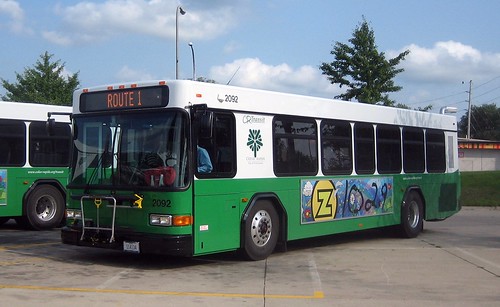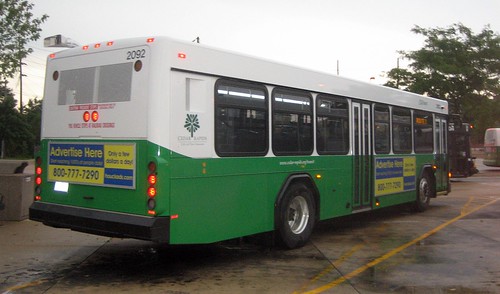
Like I said, I was in Chicago a week or so ago visiting Hyde Park for a transportation node project for studio. Our project site is centered around 57th Street and the Metra station so this is the area I spent the most time in. This area was largely residential with just a few cafes, small bookstores, and grocery stores. We were in the neighborhood both Sunday and Monday to see any variation between weekday and weekend activity.
Hyde Park encompasses the campus of the University of Chicago, the Robie House, and the Museum of Science and Industry along with great parkland along Lake Michigan that was the site of the “White City” for the 1893 Columbia Exposition. The neighborhood developed starting in the mid 1800s around the Illinois Central Railroad which is the present day Metra line.
 57th Street between Kimbark and the Metra tracks is a nice mix of small businesses, town houses and apartments, a school and a small park with a playground. It felt like a perfect example of a good urban neighborhood. The days of visit were very cold so not many people were out and about. I was drawn to the block by the school and playground; across the street is a small strip of businesses including a bakery, small grocery store and a floral shop among others. Although 53rd Street a few blocks north has many more businesses, this block serves as a micro-center for the immediate blocks around it. The park and school act as a public gathering space and the shops provided daily amenities, surrounded by dense but comfortable townhouses and small apartment buildings.
57th Street between Kimbark and the Metra tracks is a nice mix of small businesses, town houses and apartments, a school and a small park with a playground. It felt like a perfect example of a good urban neighborhood. The days of visit were very cold so not many people were out and about. I was drawn to the block by the school and playground; across the street is a small strip of businesses including a bakery, small grocery store and a floral shop among others. Although 53rd Street a few blocks north has many more businesses, this block serves as a micro-center for the immediate blocks around it. The park and school act as a public gathering space and the shops provided daily amenities, surrounded by dense but comfortable townhouses and small apartment buildings.
The blocks around 57th Street were not very busy early Sunday afternoon. There were a few dog walkers here and there and some college student indulging in childhood fun at the park’s playground. The couple of cafes and restaurants on 57th were open for business as well as a charming used bookstore. While looking around at the bookstore a few UC students came in to look at the store’s random stock of used suite jackets. Two women stopped in for a few minutes but decided not to buy anything that day; evidently they were regulars.
 Expecting bustling streets during the weekday, Monday came with a bit of a let down. 57th. Street was not packed with pedestrians, but businesses and the school were running as normal. Vehicular traffic was slightly higher when we arrived back in the neighborhood around 9am. A cyclist was locking up his bike to a sign post. A woman parked her car to patronize one of the local businesses. Recess time – school children took over the playground that UC students had occupied the day before. As I walked by the corner cafe it was full and alive with a range from business people to blue collar. Today’s activity was very routine – just another morning in the neighborhood.
Expecting bustling streets during the weekday, Monday came with a bit of a let down. 57th. Street was not packed with pedestrians, but businesses and the school were running as normal. Vehicular traffic was slightly higher when we arrived back in the neighborhood around 9am. A cyclist was locking up his bike to a sign post. A woman parked her car to patronize one of the local businesses. Recess time – school children took over the playground that UC students had occupied the day before. As I walked by the corner cafe it was full and alive with a range from business people to blue collar. Today’s activity was very routine – just another morning in the neighborhood.
I really enjoyed the small neighborhood park. It had many pathways leading into the playground with long wooden benches placed to the sides. The benches were not the most attractive and the paths were not pristine but they proved functional and usable. I would choose this charming active, but imperfect neighborhood park over a lifeless, perfectly landscaped suburban park any day.
The Metra tracks form a physical and psychological barrier between the dense neighborhood of Hyde Park to the west and the open park space to the east along Lake Michigan. Walking from the neighborhood through the 57th Street underpass was like the entrance to Frank Lloyd Wright’s Robie House about 6 blocks away. Businesses and apartments were built up right against the Metra tracks. The overpass was dark and cool with multiple arcades of small arches and columns. The underpass is low and constricting, pushing one through the space. An opening above in the center provides relief, allowing some light in. On the east, one is released into the very open boulevard of Stony Island Avenue and Jackson Park. The monumental Museum of Science and Industry building can be seen beyond the park.
 The Metra station and its overpasses over 56th and 57th streets are gritty and a little dirty. The platform provides wonderful views of the immediate blocks. It gives a glimpse into what the neighborhood might hold to a first time visitor like myself. A lot of trash and junk cars along the adjacent street give the impression that the neighborhood will be dirty and unkept. However that is not the case. The streetscaping and building facades along 57th and subsequent cross streets are pleasing and at an appropriate human scale. Homes and businesses open out to the sidewalk encouraging active streets and community interaction. Interestingly the implementation of a newer, modern townhouse project directly across the street from the Metra tracks challenges this common idea of where public activity should take place. Surrounding an interior courtyard, with garages facing the existing public street, these townhouse do not encourage the kind of street activity the older buildings and homes do. Many of the small garage and yard areas facing the street looked under-maintained and were scattered with litter. The whole area right around station felt barren and unwelcoming. I believe this is largely due to the orientation of these town houses.
The Metra station and its overpasses over 56th and 57th streets are gritty and a little dirty. The platform provides wonderful views of the immediate blocks. It gives a glimpse into what the neighborhood might hold to a first time visitor like myself. A lot of trash and junk cars along the adjacent street give the impression that the neighborhood will be dirty and unkept. However that is not the case. The streetscaping and building facades along 57th and subsequent cross streets are pleasing and at an appropriate human scale. Homes and businesses open out to the sidewalk encouraging active streets and community interaction. Interestingly the implementation of a newer, modern townhouse project directly across the street from the Metra tracks challenges this common idea of where public activity should take place. Surrounding an interior courtyard, with garages facing the existing public street, these townhouse do not encourage the kind of street activity the older buildings and homes do. Many of the small garage and yard areas facing the street looked under-maintained and were scattered with litter. The whole area right around station felt barren and unwelcoming. I believe this is largely due to the orientation of these town houses.
The beauty of Hyde Park is in its diversity, of land uses and people. College students, life-long residents, rich and poor coexist in harmony here. The neighborhood’s massing and density benefits pedestrians, cyclists, and transit users, while still providing relative convenience for those with private automobiles. The sidewalks are pleasant and safe to walk on. The streets are narrow enough to not overwhelm pedestrians and cyclists yet wide enough to provide parking in most places. Hyde Park is a great example of a vibrant, sustainable, urban neighborhood – the kind of place where I would love to live and raise a family someday.
See all my Hyde Park and Chicago photos here.







